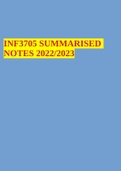Summary
Summary INF3705 SUMMARISED NOTES 2022/2023
- Institution
- University Of South Africa
INF3705 SUMMARISED NOTES 2022/2023 CHAPTER 3 – PROCESSMODELS. 1.1 P RESCRIPTIVEMODELSORCONVENTIONALMODELS. Every software engineering organization should describe a unique set of framework activities for the software processes it adopts. It should populate each framework activity with a set ...
[Show more]



